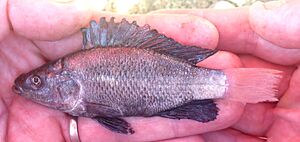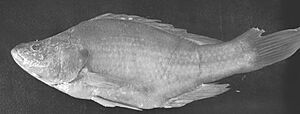Oreochromis amphimelas facts for kids
Quick facts for kids Oreochromis amphimelas |
|
|---|---|
 |
|
| A male Oreochromis amphimelas fish from Lake Manyara in 2015 | |
| Conservation status | |
| Scientific classification | |
| Synonyms | |
|
The Oreochromis amphimelas is a special type of tilapia fish. It is a cichlid and lives only in north-central Tanzania. You can find it in Lake Manyara and other salty lakes that don't have rivers flowing out of them. This fish can grow up to 28 centimeters (about 11 inches) long.
Contents
What it Looks Like
This tilapia fish looks quite unique! The front part of its head is very short. This means it has a small eye, a small mouth, and a short snout.
Smaller Oreochromis amphimelas fish have a body that looks like a cylinder. But the biggest ones have a high, curved back. Their head also curves inward. Their mouth points a bit upwards.
Female and young fish are a shiny silver-grey color. They don't have vertical stripes on their sides. They also don't have the usual 'tilapia mark' that most other tilapias have.
When male fish are ready to breed, they turn a dark pink color. Their heads and bellies become black. Their back, bottom, and side fins also turn noticeably black.
How it Got its Name
A scientist named Franz Martin Hilgendorf first described this fish in 1905. He named it Tilapia amphimelas. The name 'amphimelas' means 'double-black'. This probably refers to the dark fins of the breeding male fish.
At first, Hilgendorf thought the females of this fish were a different species. He called them Tilapia manyarae. But later, scientists realized they were the same kind of fish.
Scientists have studied this fish's genes. They found that Oreochromis amphimelas is closely related to other special cichlids. These include fish from very salty lakes like Lake Magadi and Lake Natron.
Reproduction and Life Cycle
Like other fish in its group, the Oreochromis amphimelas is a mouthbrooder. This means the mother carries her eggs and young fish in her mouth. This keeps them safe until they are ready to swim on their own.
The eggs of this fish are about 2 to 2.5 millimeters wide. In Lake Manyara, these fish become adults when they are about 7 to 8 centimeters long. Interestingly, the females often grow larger than the males. This is not common for tilapias or cichlids in general.
Where it Lives
The Oreochromis amphimelas was first found in Lake Manyara in northern Tanzania. This lake is shallow and has no rivers flowing out of it. Its water level changes a lot with the seasons and years. This causes the water's saltiness and alkalinity to change too.
This fish has also been found in Lakes Eyasi, Kitangiri, and Singida. These lakes also don't have rivers flowing out. However, Kitangiri and Singida are usually less salty. In these less salty lakes, the Oreochromis amphimelas can grow much bigger. They can reach up to 33 centimeters (about 13 inches) long. In the saltier Lakes Manyara and Eyasi, they usually only grow to about 13 centimeters.
Recently, this fish was also seen in another salty lake called Lake Sulunga, near Dodoma.
Conservation and Threats
People fish for Oreochromis amphimelas a lot where it lives. This fish is facing threats from other types of tilapia fish that have been brought into its waters. These include species like Oreochromis esculentus, Oreochromis niloticus, Oreochromis leucostictus, and Coptodon spp..
Some of these new fish species might be mixing with Oreochromis amphimelas. This means they are creating hybrid fish. This can be a problem because it might reduce the number of pure Oreochromis amphimelas fish.



